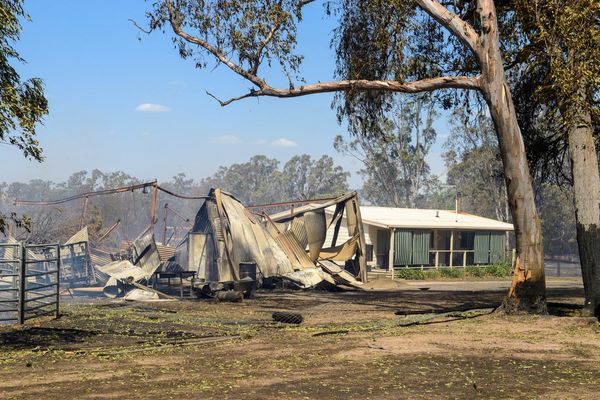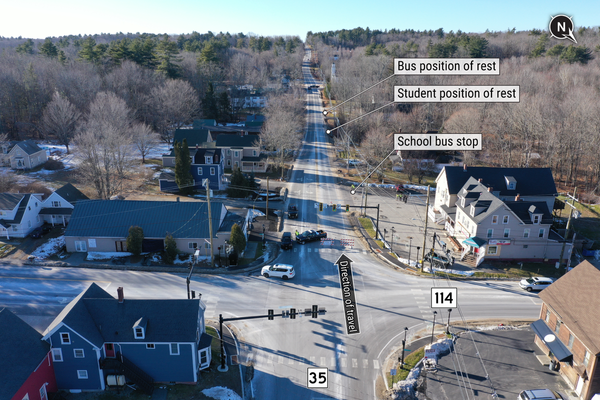Alarm bells are being rung about a looming "sub-prime" crisis that could see banks exposed to the elements and more borrowers turned away from home loans in areas prone to extreme weather.
Climate change is something many borrowers are not factoring in when they buy a property, but risk assessors say it should be top of mind.
Ahmad Tabish and his young family just moved to the regional Victorian city of Shepparton for his new job.
He loves the "beautiful city" but is aware of it's vulnerability.
Shepparton's town centre is along the Goulburn River. Homes near it are prone to flooding.
Mr Ahmad is considering staying in Shepparton long-term and buying a house there.
"Usually, when people buy a home, especially young people, they do a lot of research in terms of the costing," he says.
"But I think now there [are] extra factors to study: How's the topography of that region? The geography of that region?
"How much is that area vulnerable to the effects of climate change, which could be bushfires, floods, droughts?"
This is something that the banks that issue home loans are increasingly thinking about too.
CBA's $31.2 billion exposure to extreme weather
Australia's biggest lender released its first climate change report in August.
The Commonwealth Bank partnered with the CSIRO to compile the report.
It noted that it currently has $31.2 billion in home loans on its books for properties in areas exposed to extreme weather risks, including cyclones, floods and bushfires.
The bank noted that it was using a severe physical risk scenario that assumes an increase in temperatures of up to 4.8˚C by 2100.
It also noted the $31.2 billion only made up 3.1 per cent of its home loans.
"However, we recognise that, as Australia’s largest bank, our performance is highly correlated to the Australian economy," it said.
Another major lender, Westpac, has also looked at this.
It found a similar rate of exposure to CBA on its mortgage portfolio, at around 3.3 to 3.8 per cent by 2050, depending on what temperature level projections were used.
How are banks making these projections?
None of the big four banks would be interviewed about this.
However, in its report, the CBA said its home loan risk-evaluation took into account "assumptions regarding insurance coverage, default probability and real estate valuation impacts".
Claire Ibrahim is an economist for Deloitte Access Economics who has an insight into how the finance sector is thinking about climate risk.
"If you think about how people are given mortgages today, part of that equation is [the property's] ability to be insured," Ms Ibrahim says.
"Insurance obviously protects the home owner, but it also protects the bank, to the extent that there is a natural disaster."
The issue for a bank arises when it approves a home loan, and then down the track getting insurance on that property becomes a problem — say, because it gets deemed more at risk of floods or fires.
Insurance premiums for areas are typically updated yearly. They can easily spike after a region is impacted by a major event such as a flood or cyclone.
How do you factor that into a 25 to 30-year home loan?
In a speech in August, the Reserve Bank of Australia's Jonathan Kearns noted this dilemma for banks.
"Loan contracts are much longer than insurance contracts," the central bank's economist said.
"Over these horizons, the effects of climate change are likely to be significant, but are also very uncertain.
"The borrower may not retain insurance, either because insurers won't cover it or the cost of insurance has increased significantly.
"If climate change means a home isn't insured, then lenders could find that damage from flood, storm or fire results in the collateral value being significantly lower."
Obviously, this is dependent on what the insurance industry does.
In a report just last month, its advocacy group, the Insurance Council of Australia, looked at this issue in relation to climate change.
"At present, no region in Australia is uninsurable. However, some regions may become increasingly difficult to insure as extreme weather risks grow," the report said.
The ICA's chief operating officer, Kylie McFarlane, told The Business that the only real solution to this issue was ensuring properties and communities were disaster-proofed.
She said it wasn't possible for insurers to offer banks or homebuyers longer-term forecasts on premiums, and that people should do their research about insurance prospects on a property before they buy it.
"This is why we need to see substantial investment in resilience and mitigation," she said.
What could this do to property values?
As the insurance industry gets more open about the long-term risks of premiums soaring, a conversation is starting about what this could mean for current and future home loans.
One person that ABC News spoke to anonymously for this story who lives in an area just hit by a natural disaster told us their lender is now sending them annual reminders that they need insurance.
And another major bank confirmed to ABC News that it is standard policy after a region's hit by a severe weather event that people wanting to borrow for a property there will have to receive a full, on-site evaluation.
Some banks already require higher deposits, or interest rates, on loans deemed risky for various reasons.
That is an indication of how lenders are thinking about this.
"It's very reasonable to start thinking about this, not as a future risk, but as a current risk," Ms Ibrahim says.
"This will also affect property values … over time."
Karl Mallon is the boss of a consultancy company that's going granular with insurance premium projections, climate risk and property values.
"Remember the GFC? The idea that there was there [were] sub-prime [loans]. Well, now we're looking at climate sub-prime," he says.
He also says there could be "property price corrections" for homes in high-risk locations in coming years.
"Imagine trying to buy a house where the bank won't give you a mortgage. That property is not going to be worth a lot," Mr Mallon says.
It could also tragically lock people into living into homes that aren't worth much, and they can't sell or insure. It would leave them sitting ducks.
Mr Mallon's firm, Climate Valuation, released data earlier this year, with the advocacy group the Climate Council, looking at high-risk areas across Australia.
The findings were based on a business-as-usual, high-emissions outlook for climate change.
It claimed that one in 25 Australian homes would be at high risk of becoming effectively uninsurable by 2030.
It also identified places across Australia where more than one-in-10 homes could face this risk, including parts of Brisbane.
This February marked the third major flood to hit Brisbane in 50 years.
Ms Ibrahim lives in the river city.
"People in Brisbane are particularly nervous [as we go into a] summer where they are flagging that we might see more extreme weather events occur again this year," she says.
"What people haven't factored into [the] equation is what climate change will mean for the inherent, quite physical value of their property, particularly if it experiences frequent, more-severe flooding.
"I don't think people are thinking like that at the moment."
Another place identified on Climate Valuation's list was Greater Shepparton, which brings us back to scientist Mr Ahmad.
He is aware of the risk assessment for Shepparton, which was reported by ABC News at the time with a focus on the regional city. Some locals believed the report and others didn't.
"It is still something [that] may be too early to say," Mr Ahmad says.
"But, definitely, no-one wants to risk your big investment on that. You need to give a double thought to it."
Before moving to Shepparton, Mr Ahmad worked on nanotechnology that had applications for carbon capture and storage. That's why he is passionate about preventing the worst of climate change.
Like the Insurance Council of Australia, he believes the solution to this complex problem is building resilience and ensuring the impacts of climate change are mitigated.
He wants this not just for himself, but also for the next generation, including his young baby.
"We need to be prepared and we need to prepare our future generation," he says.







